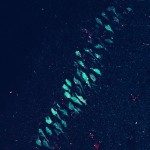Lien vers Pubmed [PMID] – 17258701
Dev. Biol. 2007 Apr;304(1):232-45
The antero-posterior dispersion of clonally related cells is a prominent feature of axis elongation in vertebrate embryos. Two major models have been proposed: (i) the intercalation of cells by convergent-extension and (ii) the sequential production of the forming axis by stem cells. The relative importance of both of these cell behaviors during the long period of elongation is poorly understood. Here, we use a combination of single cell lineage tracing in the mouse embryo, computer modeling and confocal video-microscopy of GFP labeled cells in the chick embryo to address the mechanisms involved in the antero-posterior dispersion of clones. In the mouse embryo, clones appear as clusters of labeled cells separated by intervals of non-labeled cells. The distribution of intervals between clonally related clusters correlates with a statistical model of a stem cell mode of growth only in the posterior spinal cord. A direct comparison with published data in zebrafish suggests that elongation of the anterior spinal cord involves similar intercalation processes in different vertebrate species. Time-lapse analyses of GFP labeled cells in cultured chick embryos suggest a decrease in the size of the neural progenitor pool and indicate that the dispersion of clones involves ordered changes of neighborhood relationships. We propose that a pre-existing stem zone of growth becomes predominant to form the posterior half of the axis. This temporal change in tissue-level motion is discussed in terms of the clonal and genetic continuities during axis elongation.
